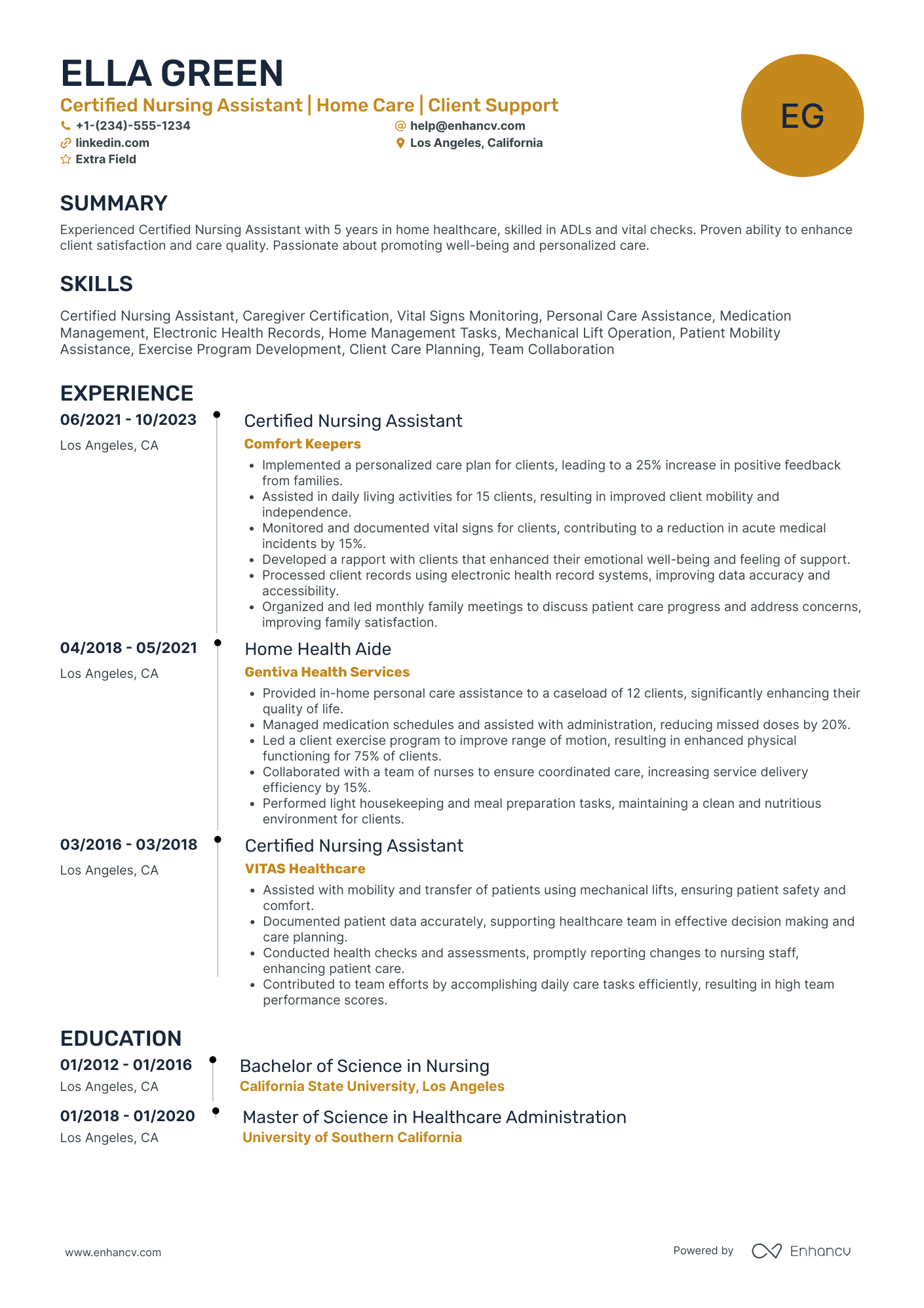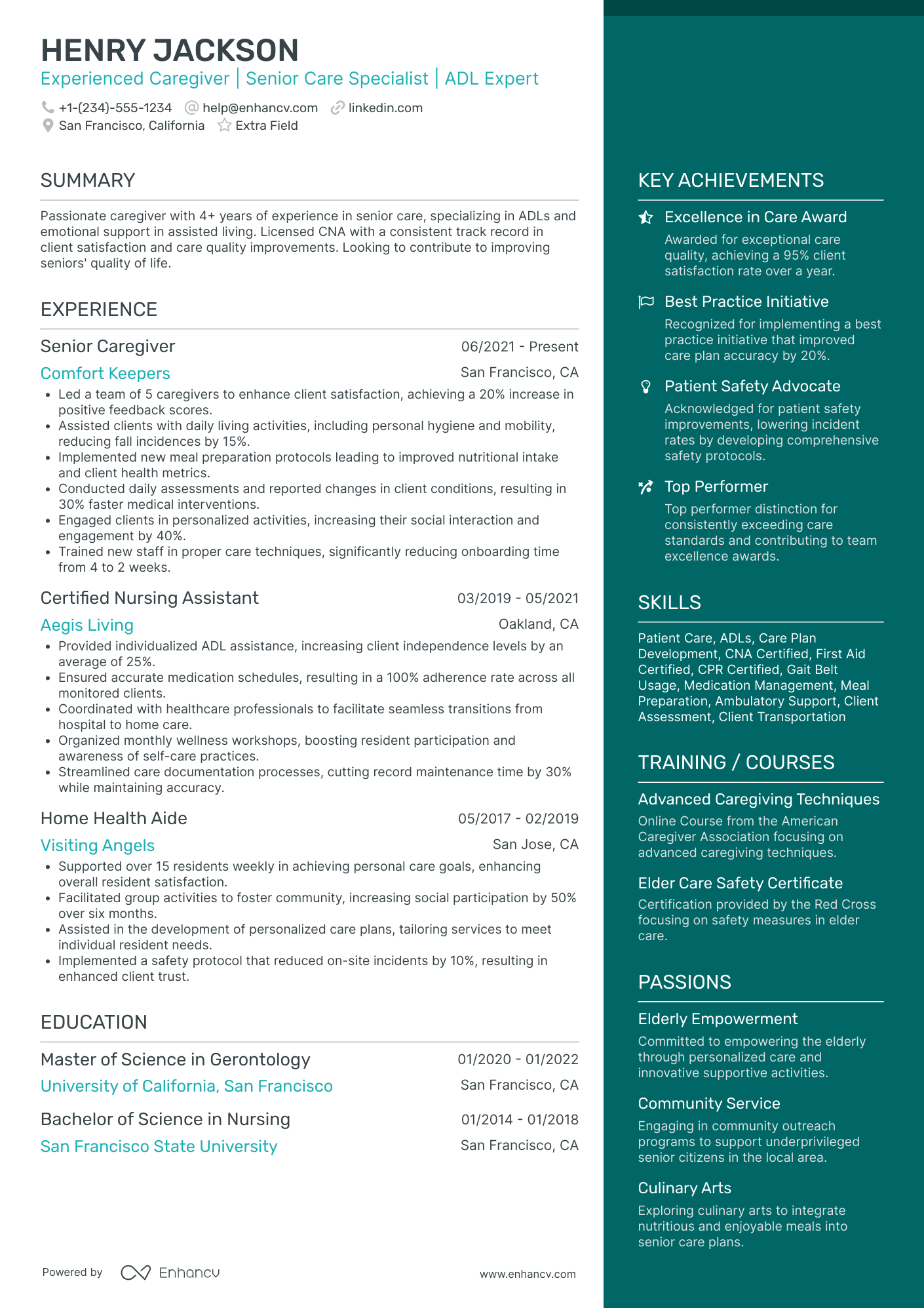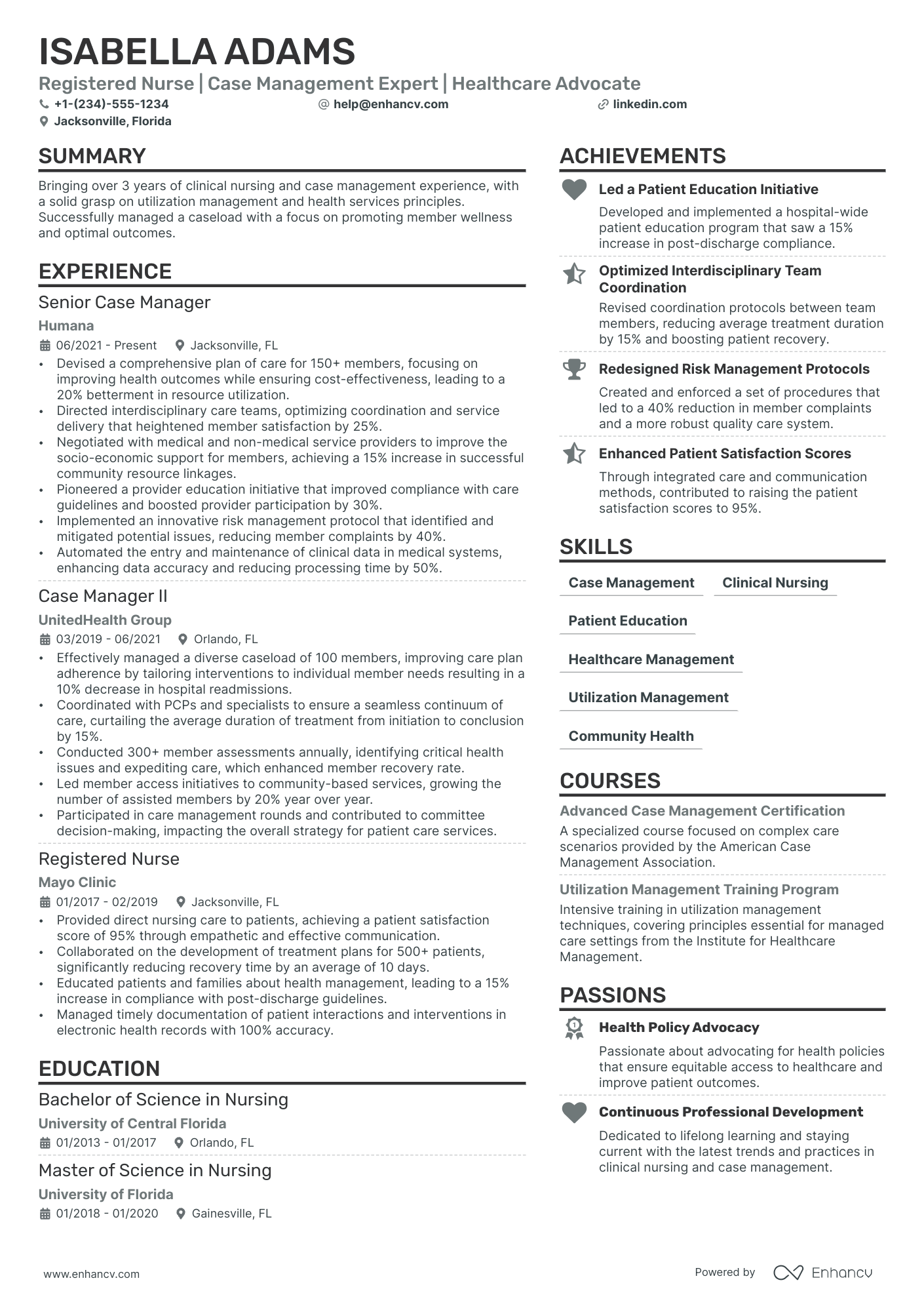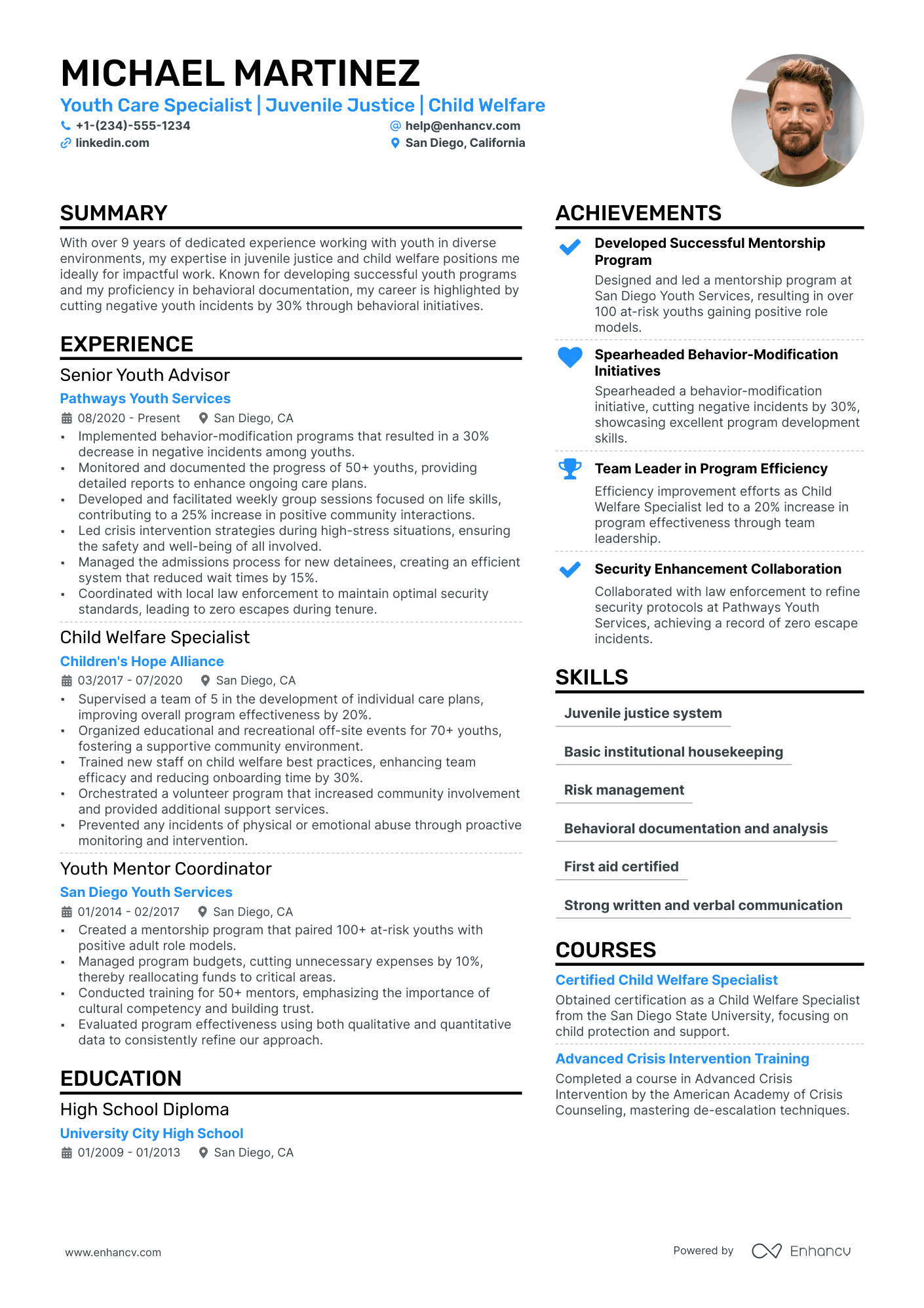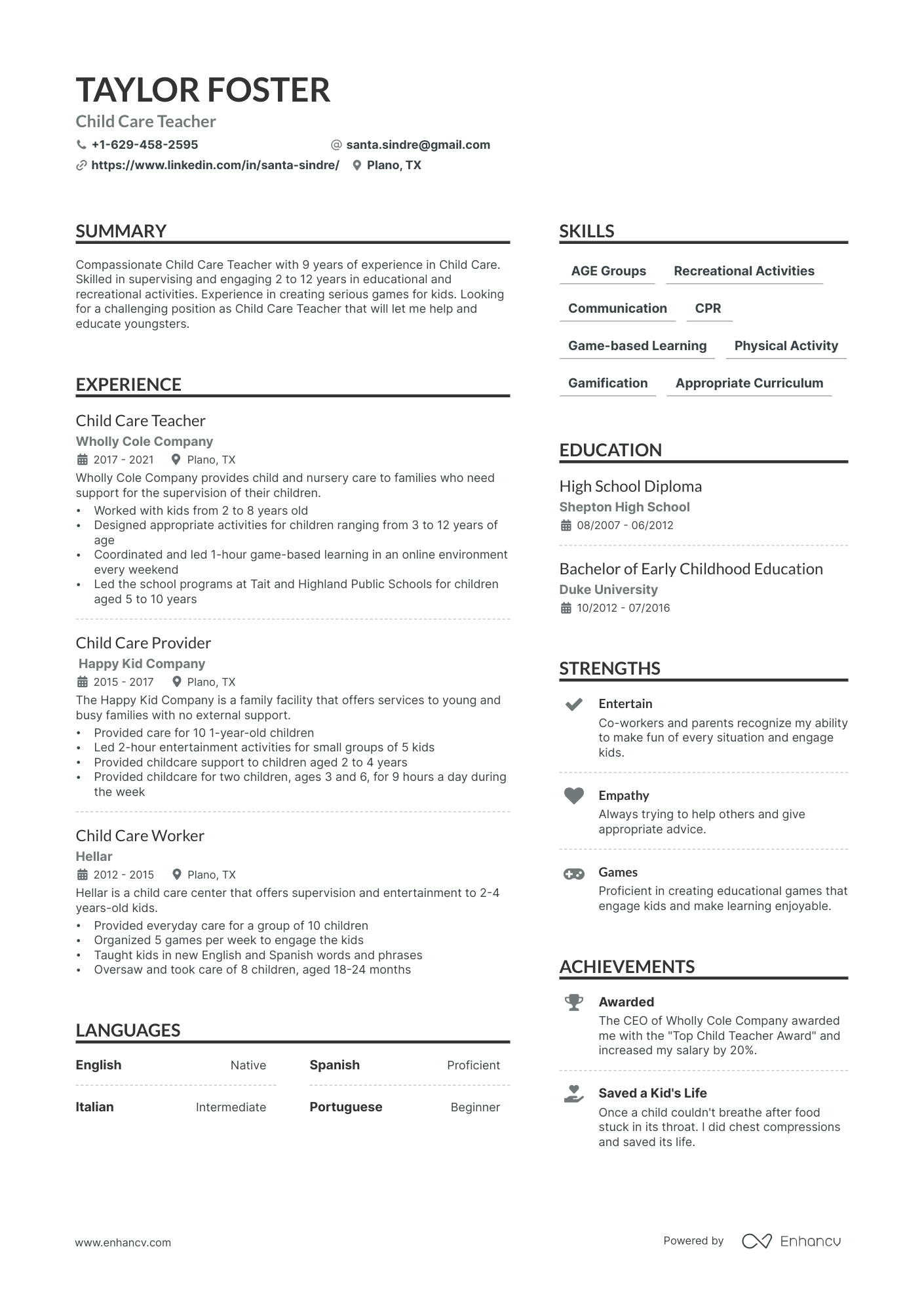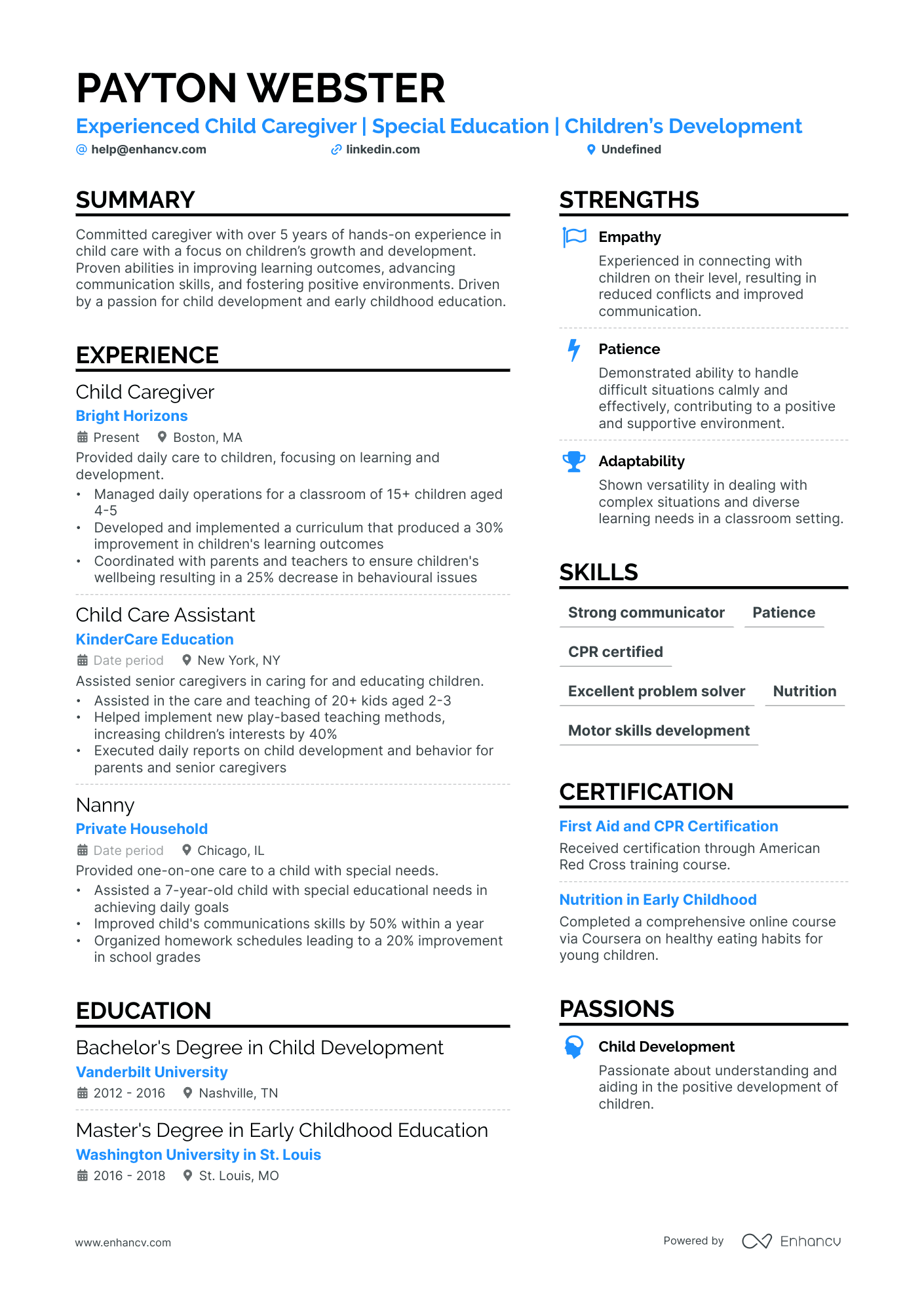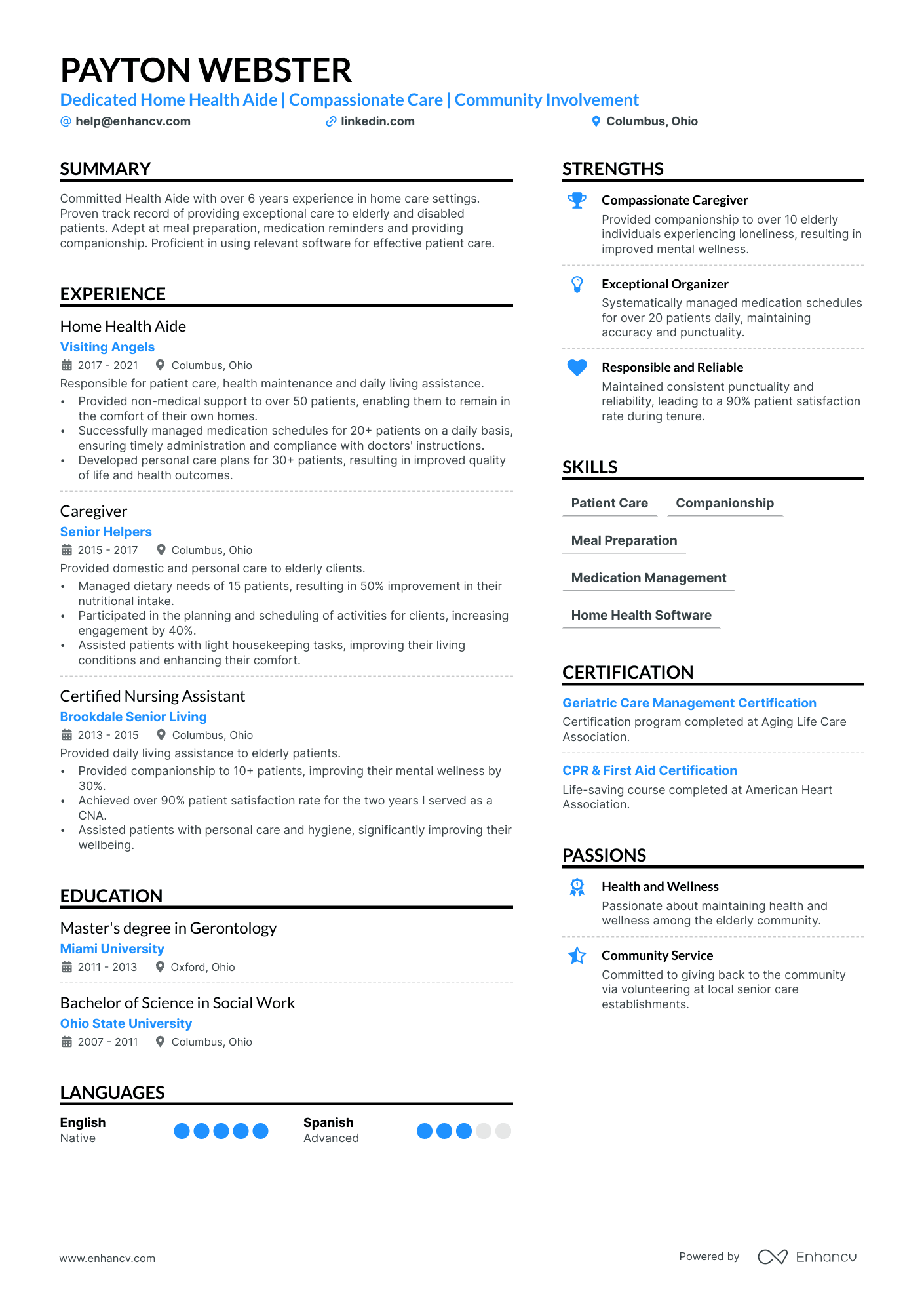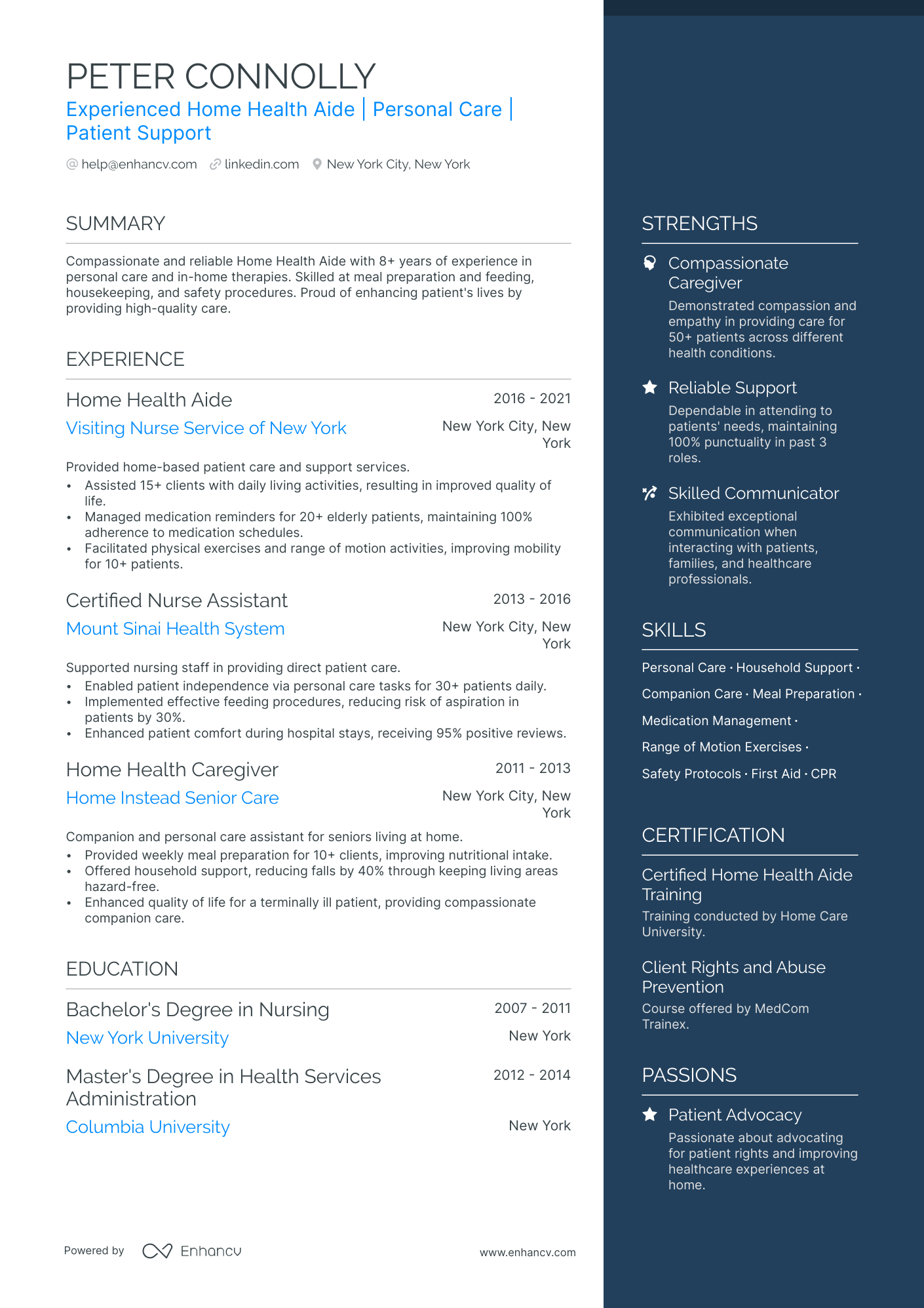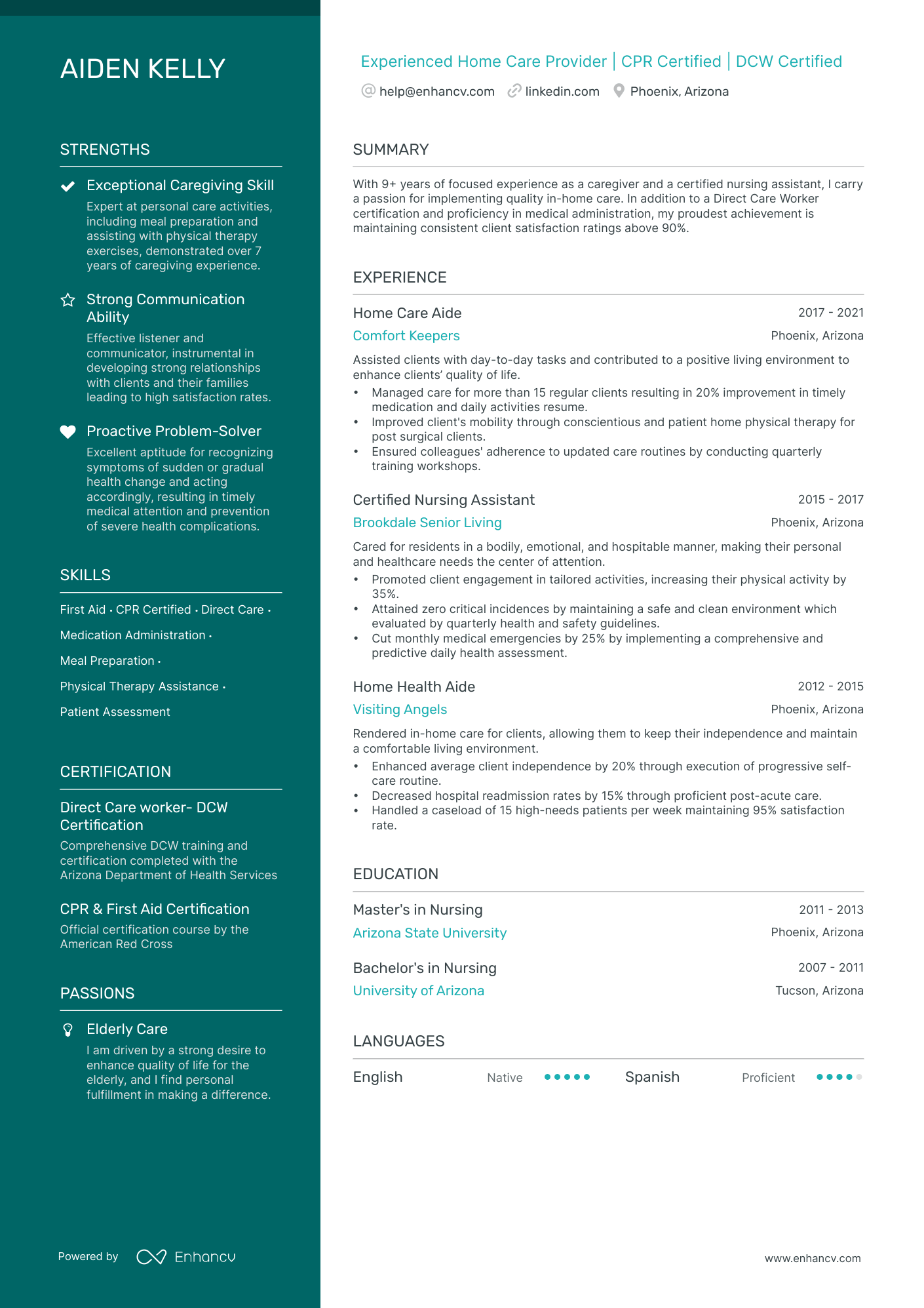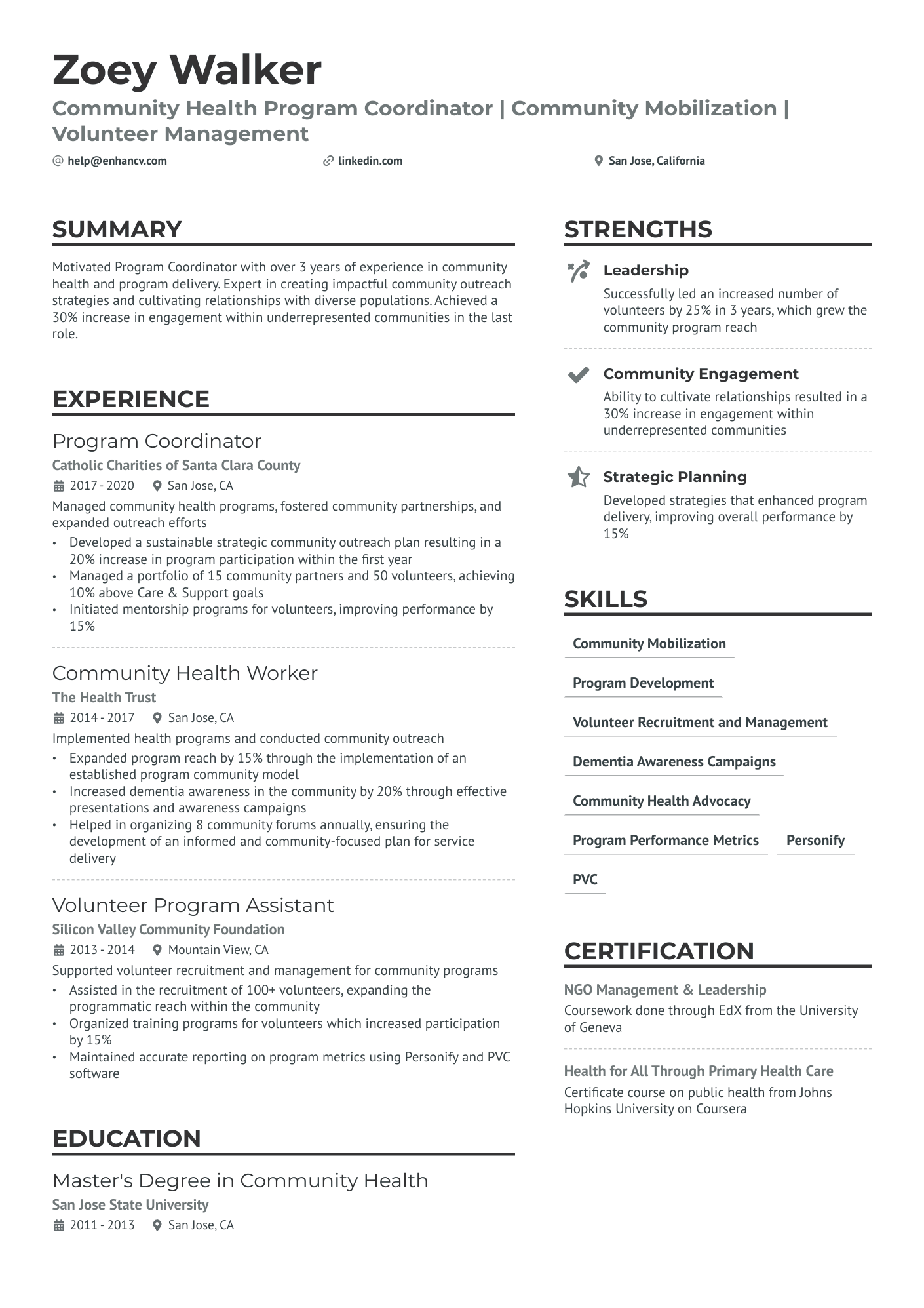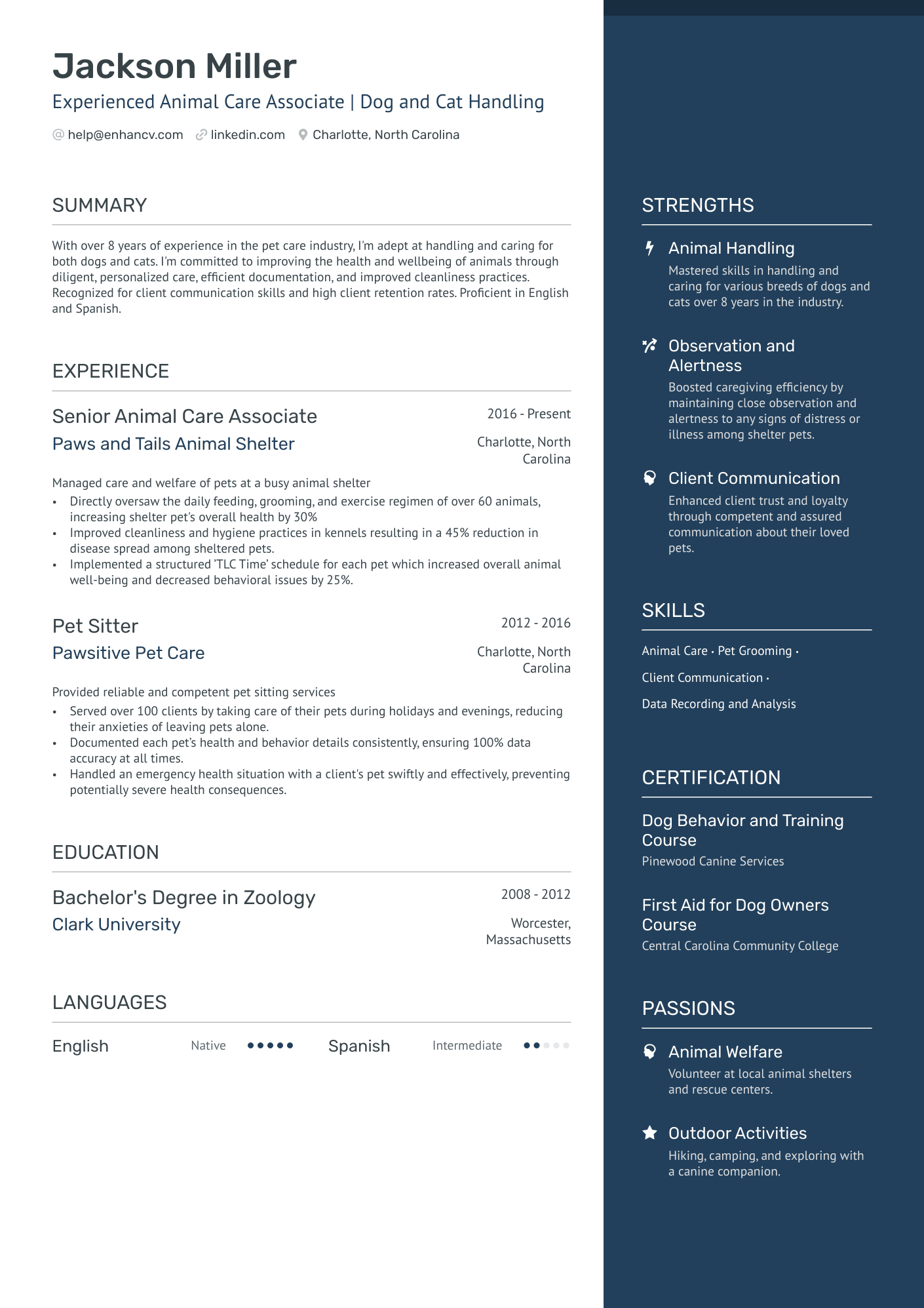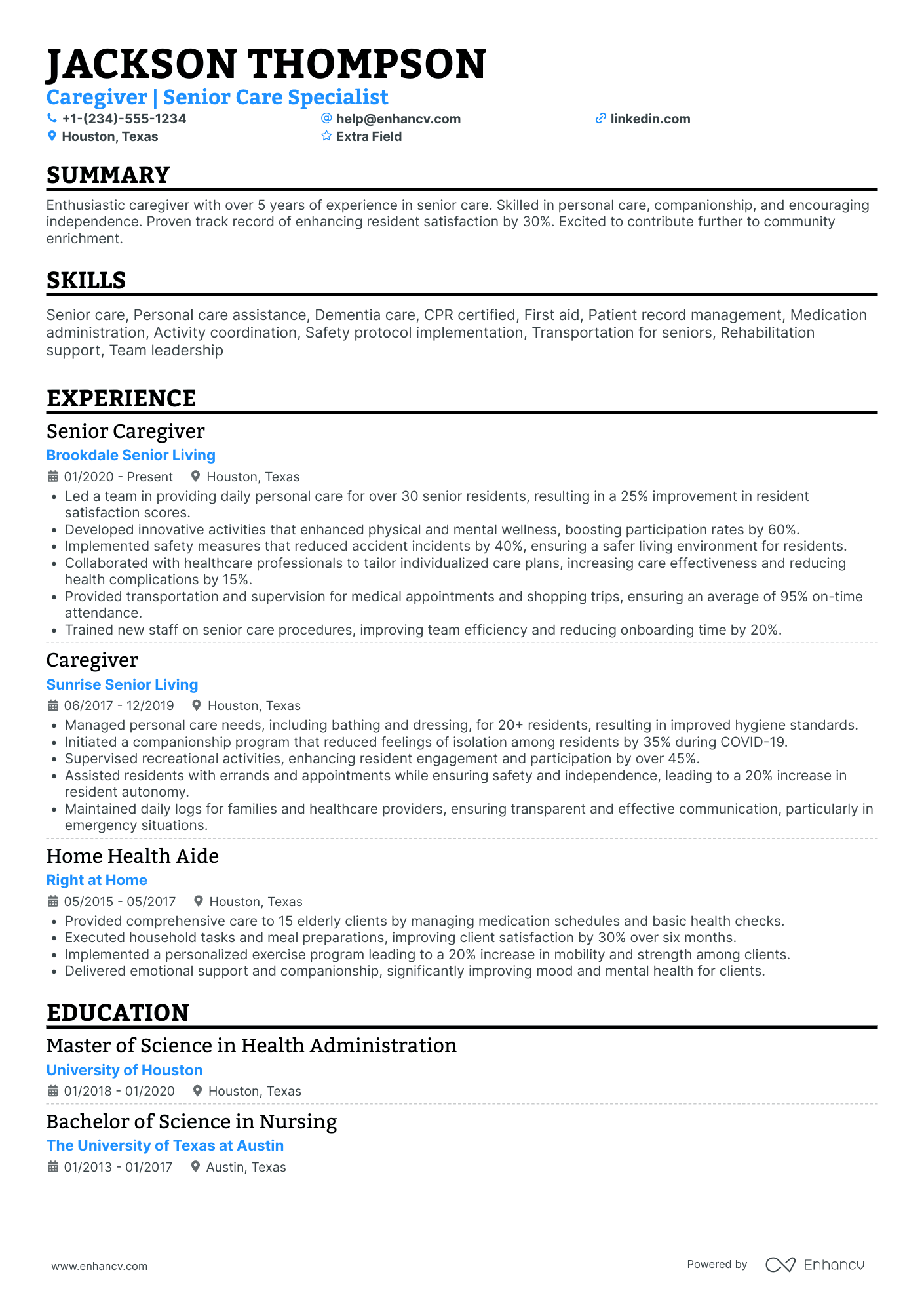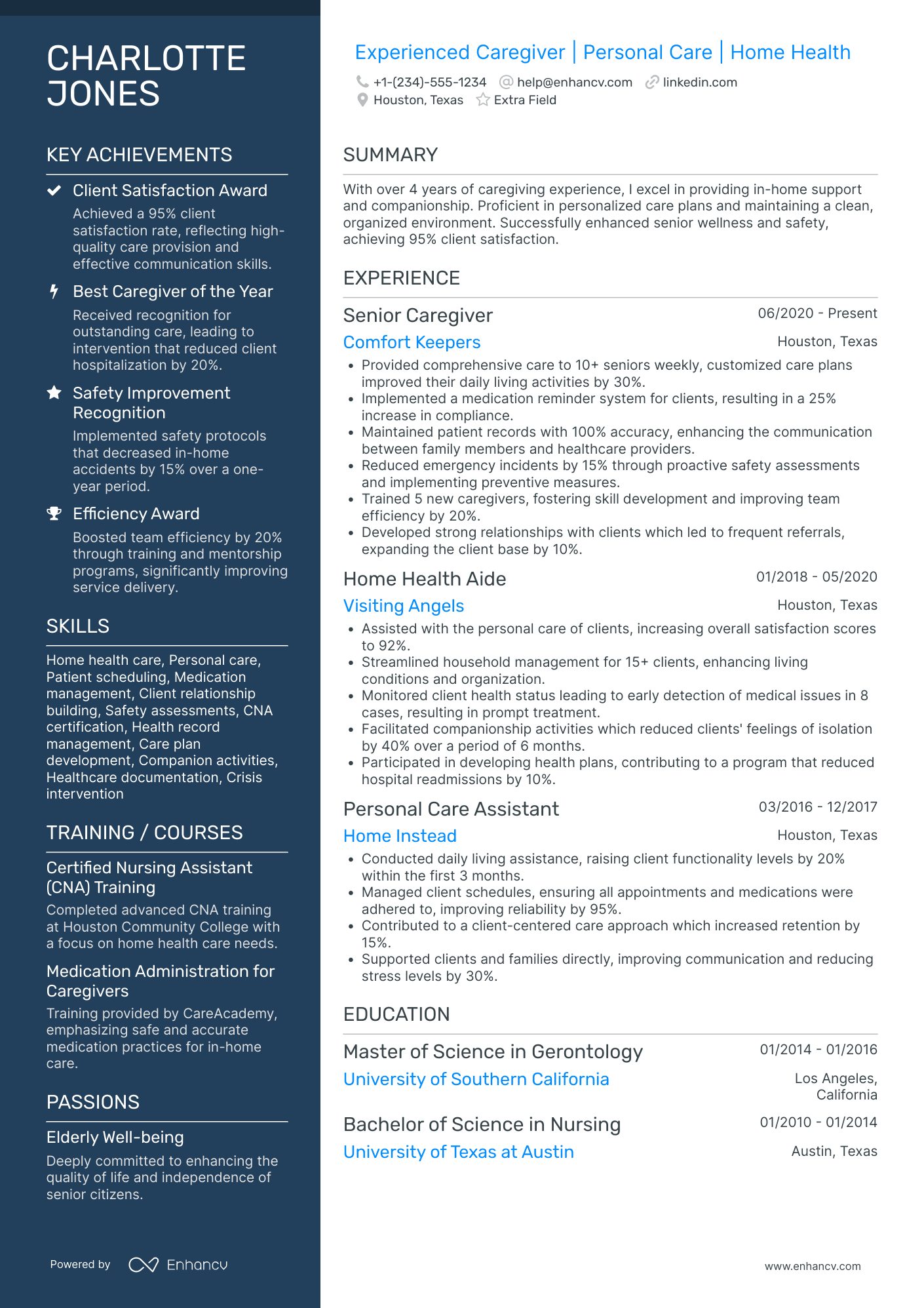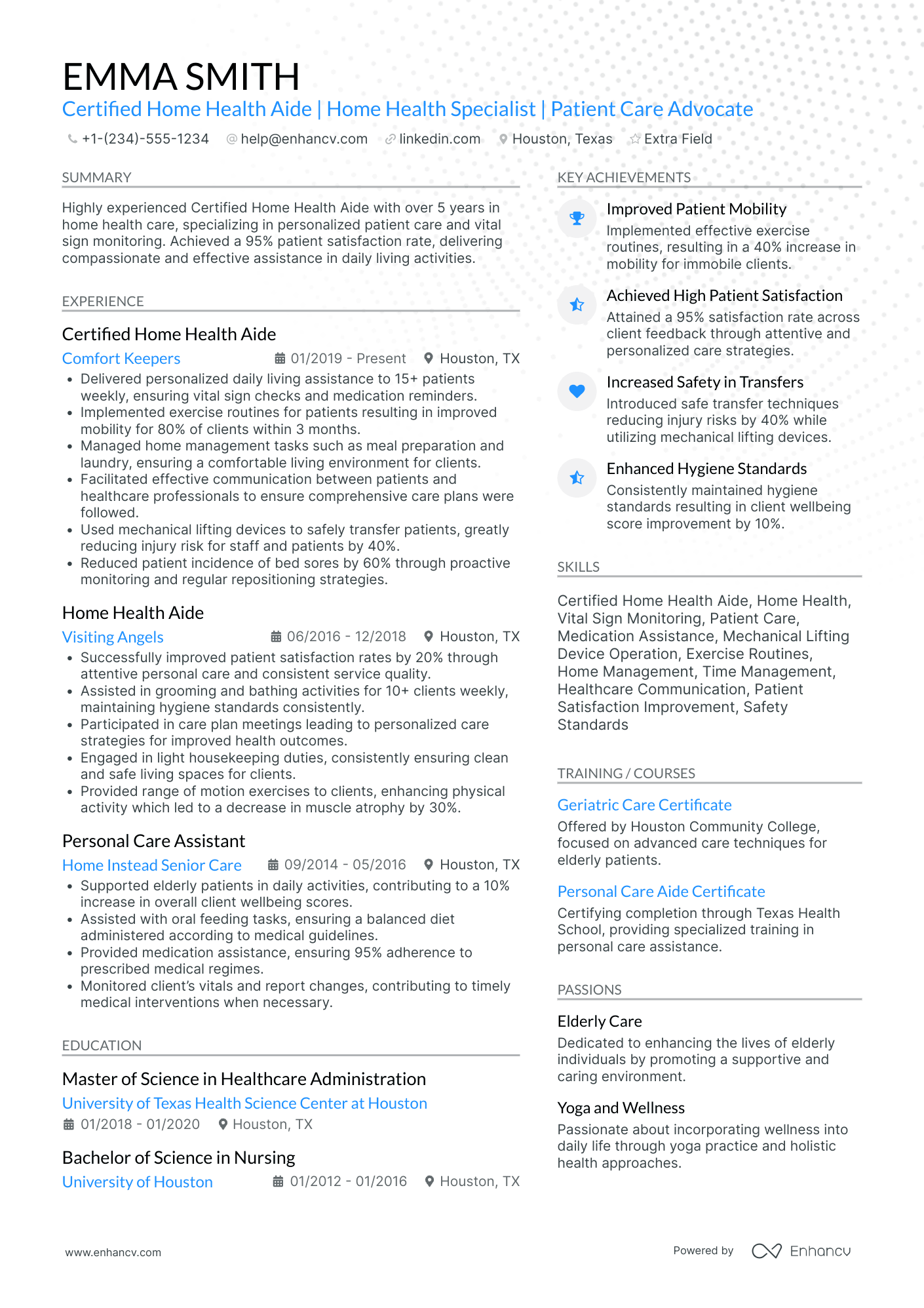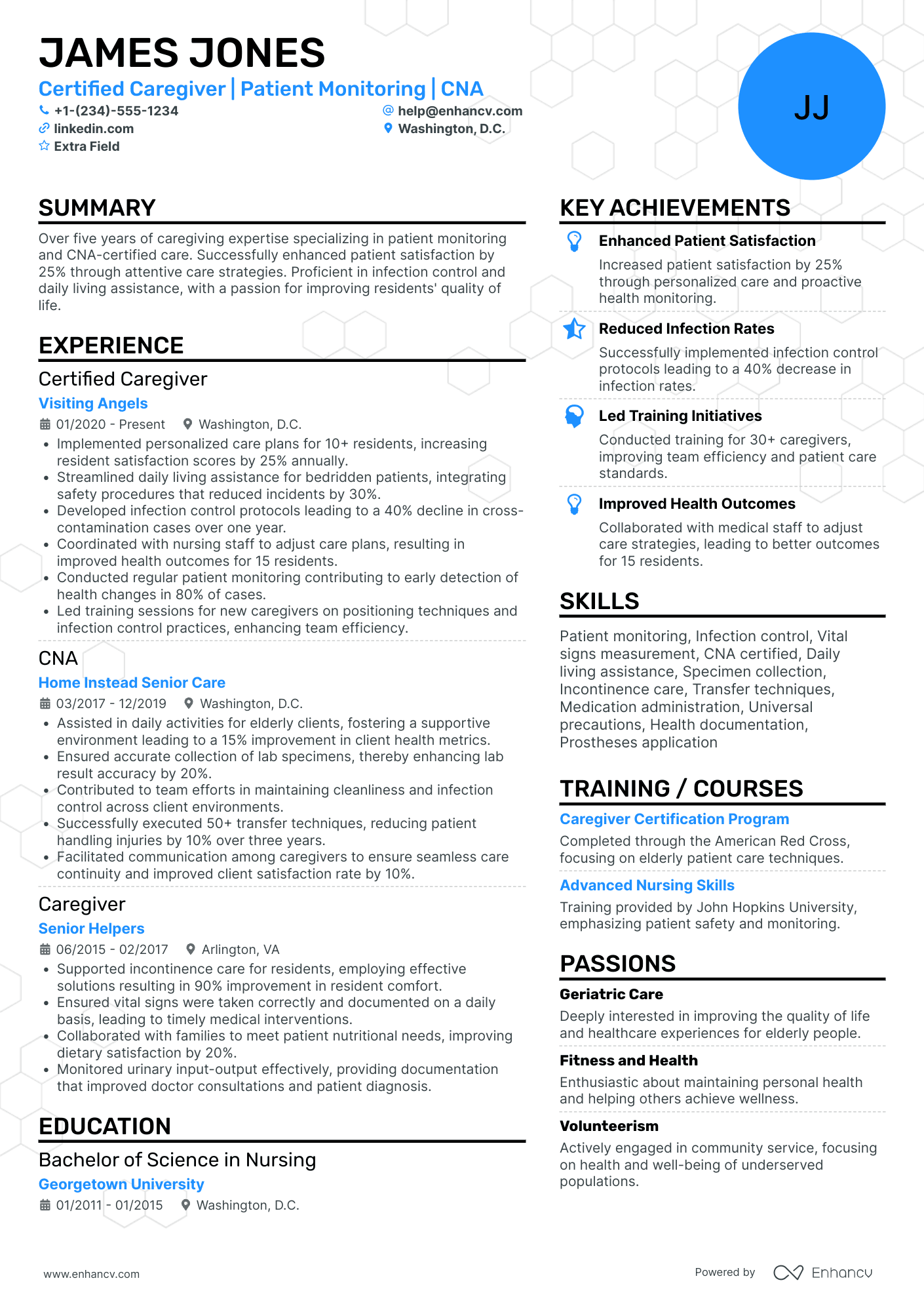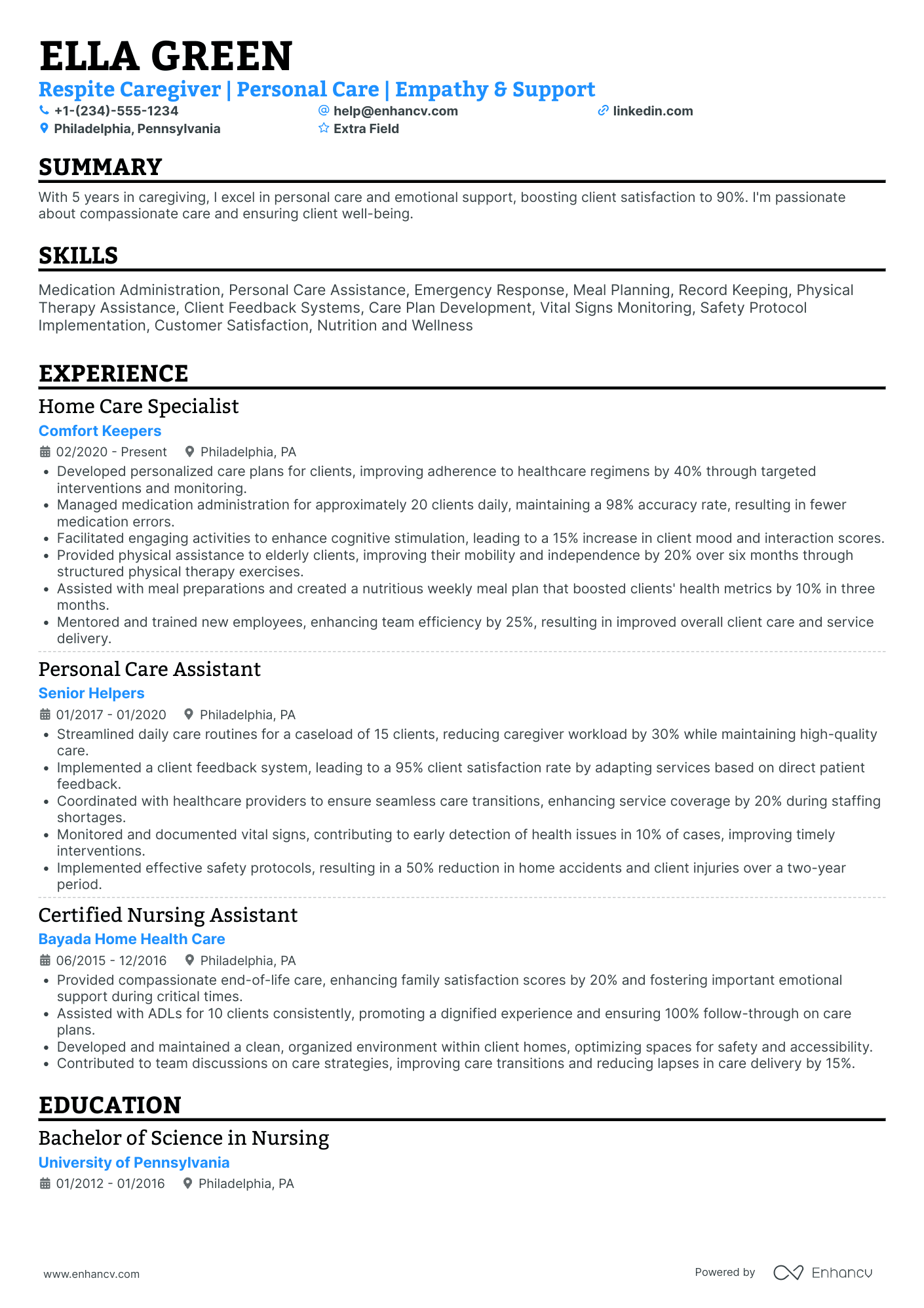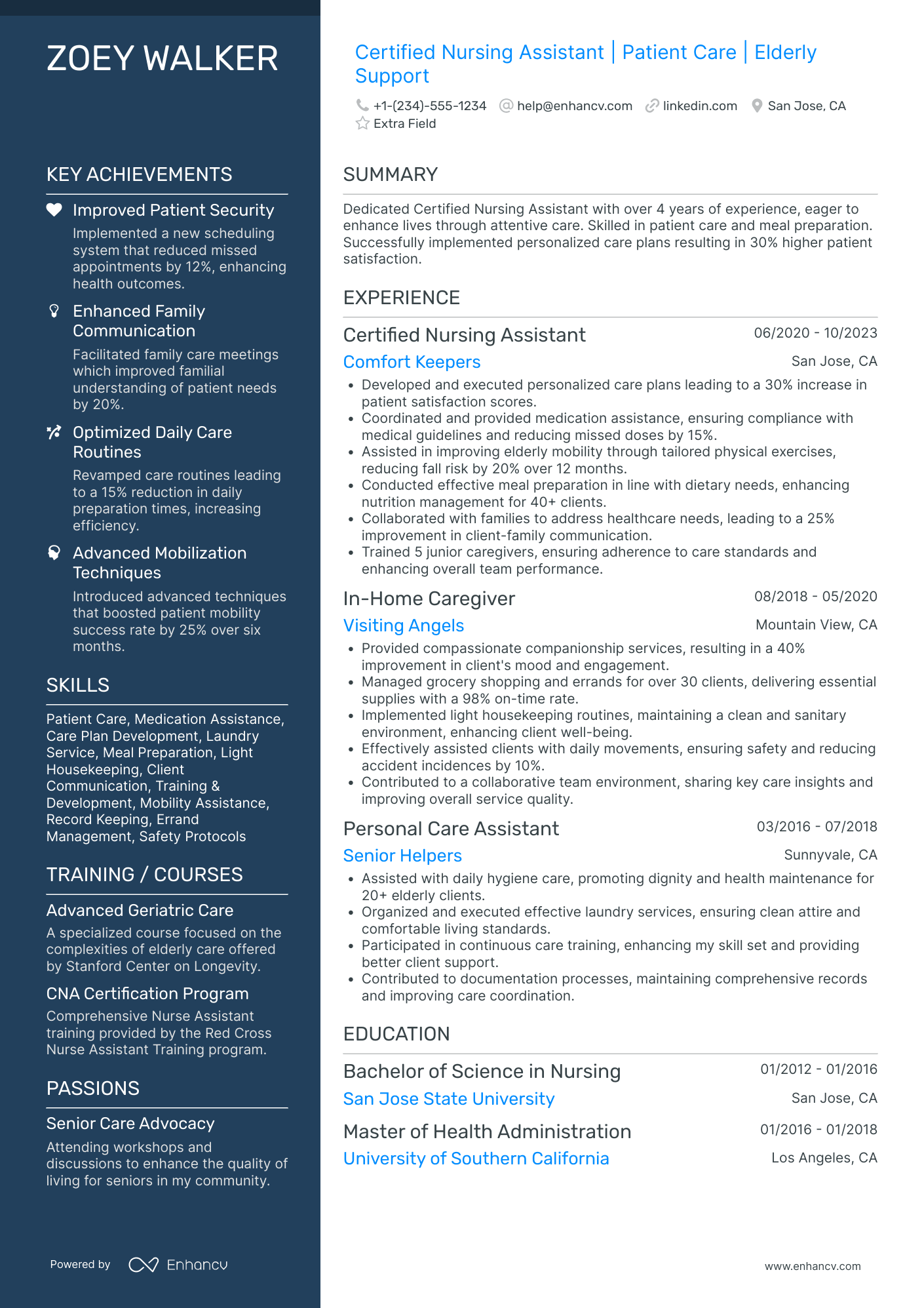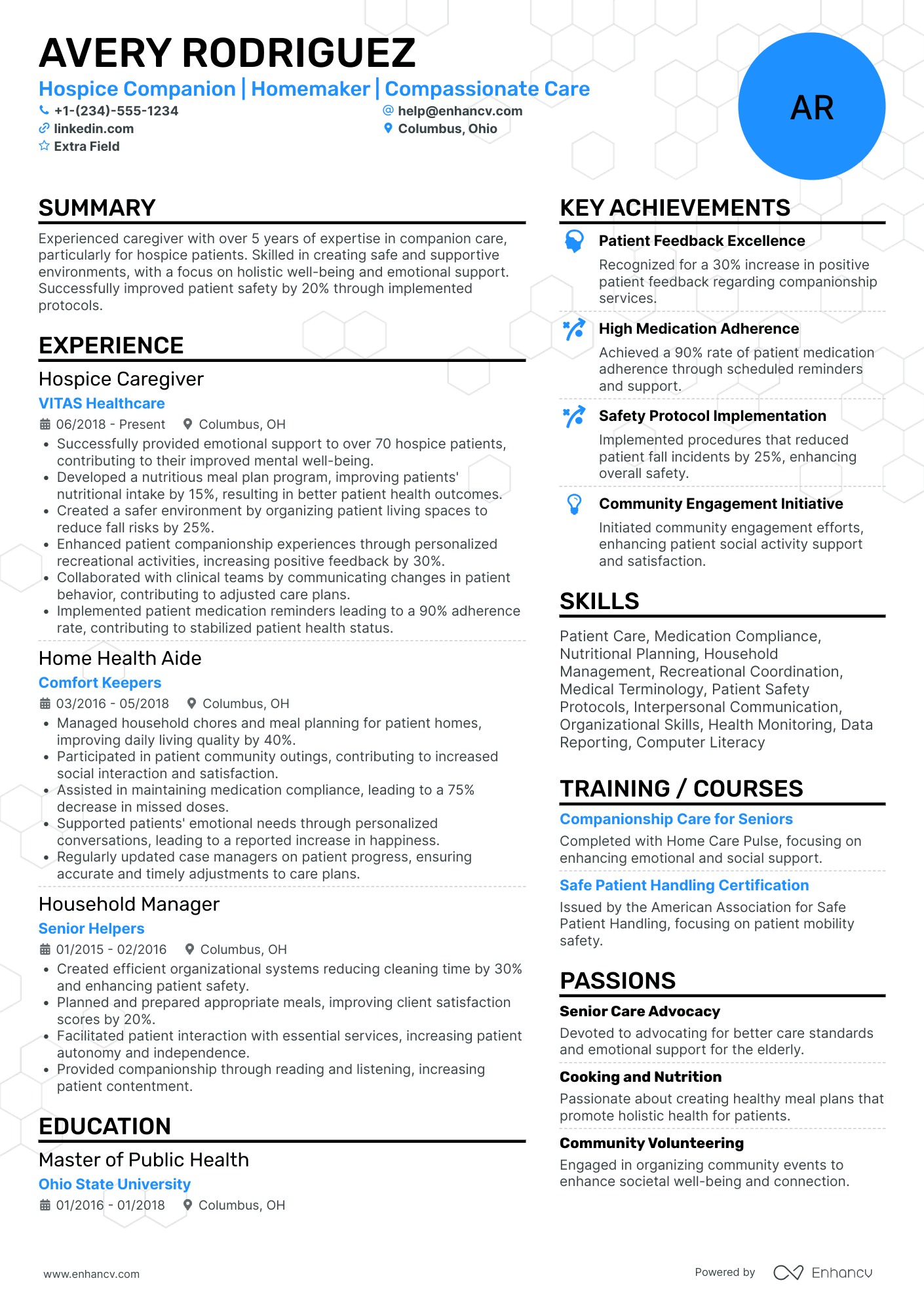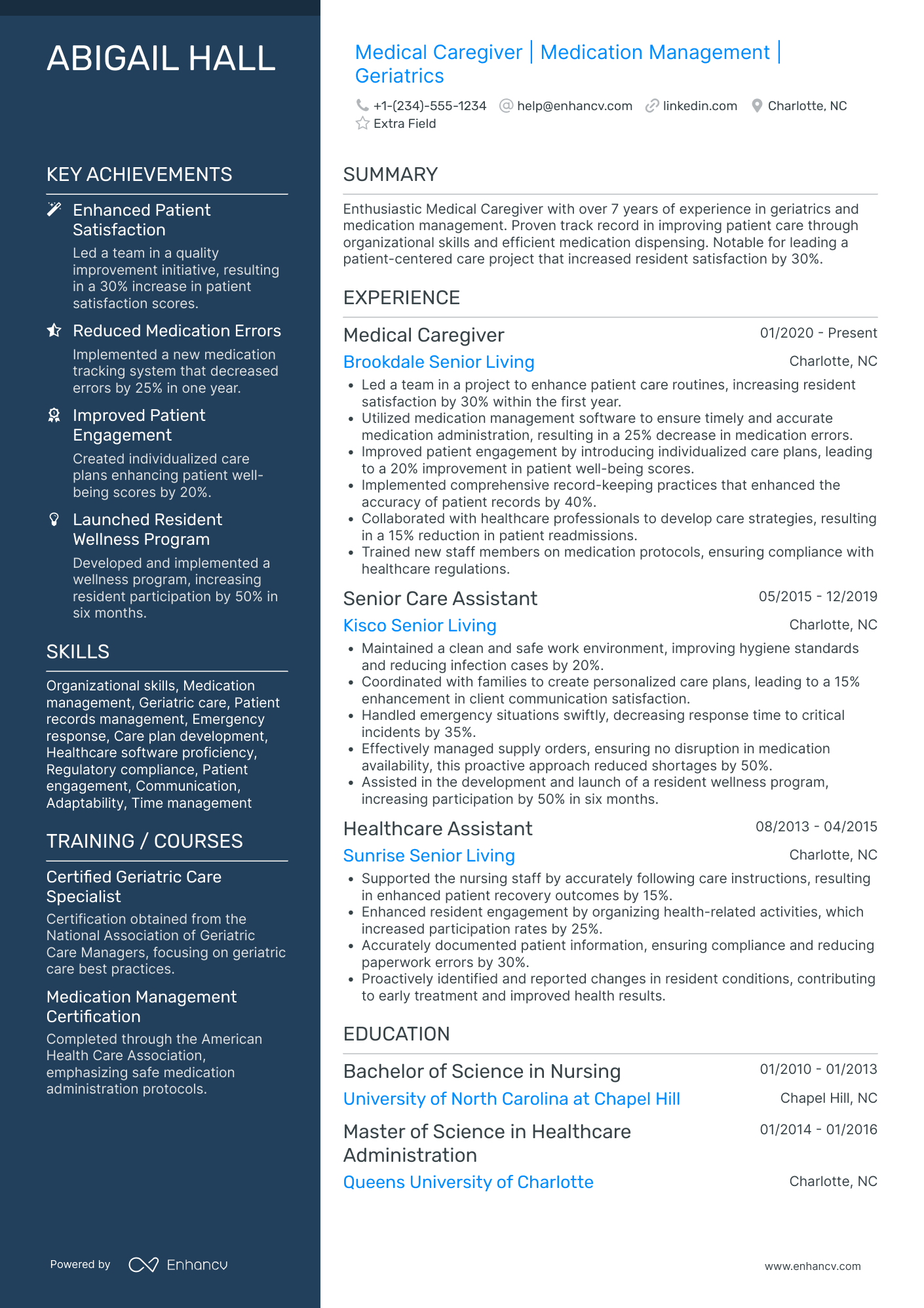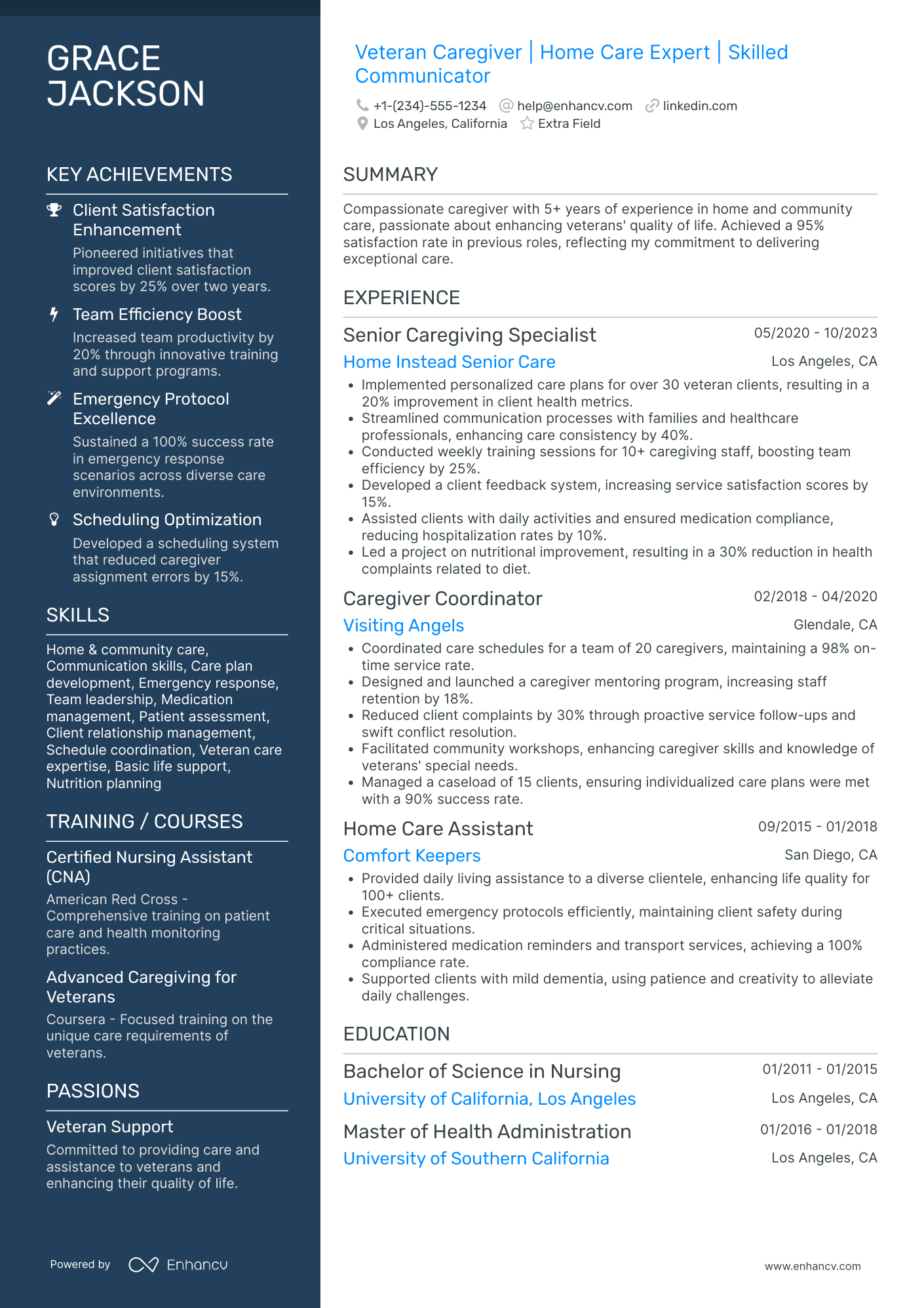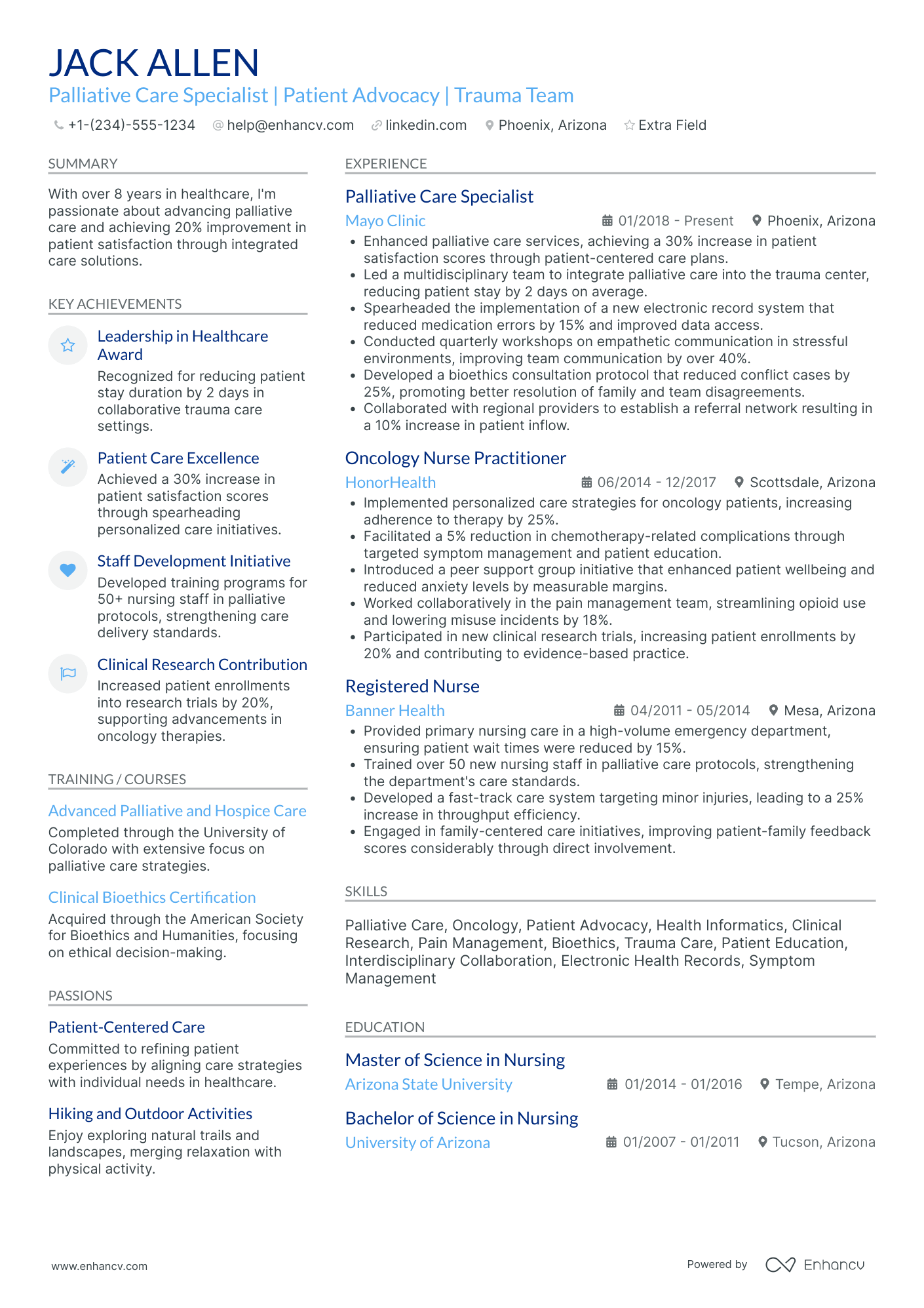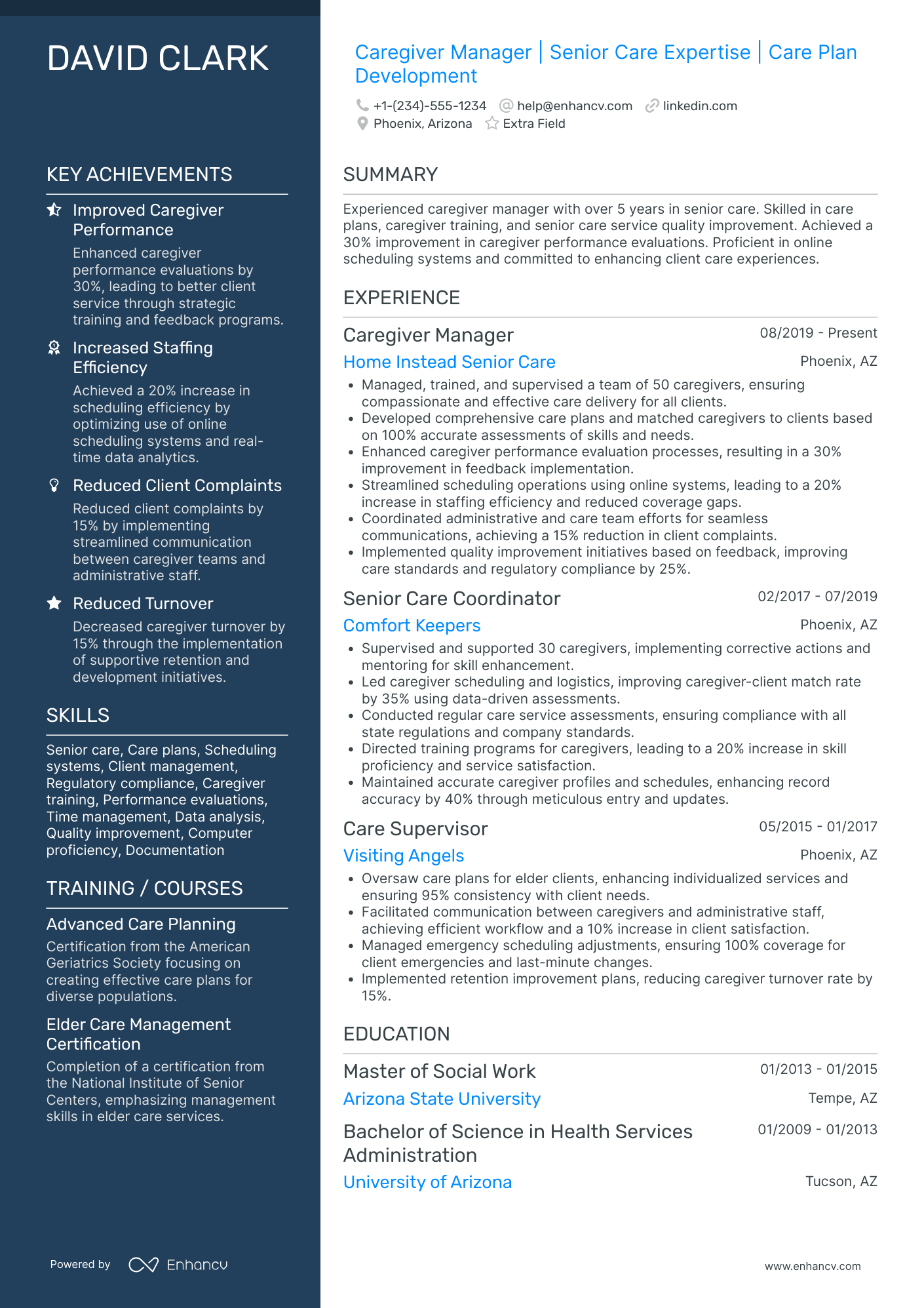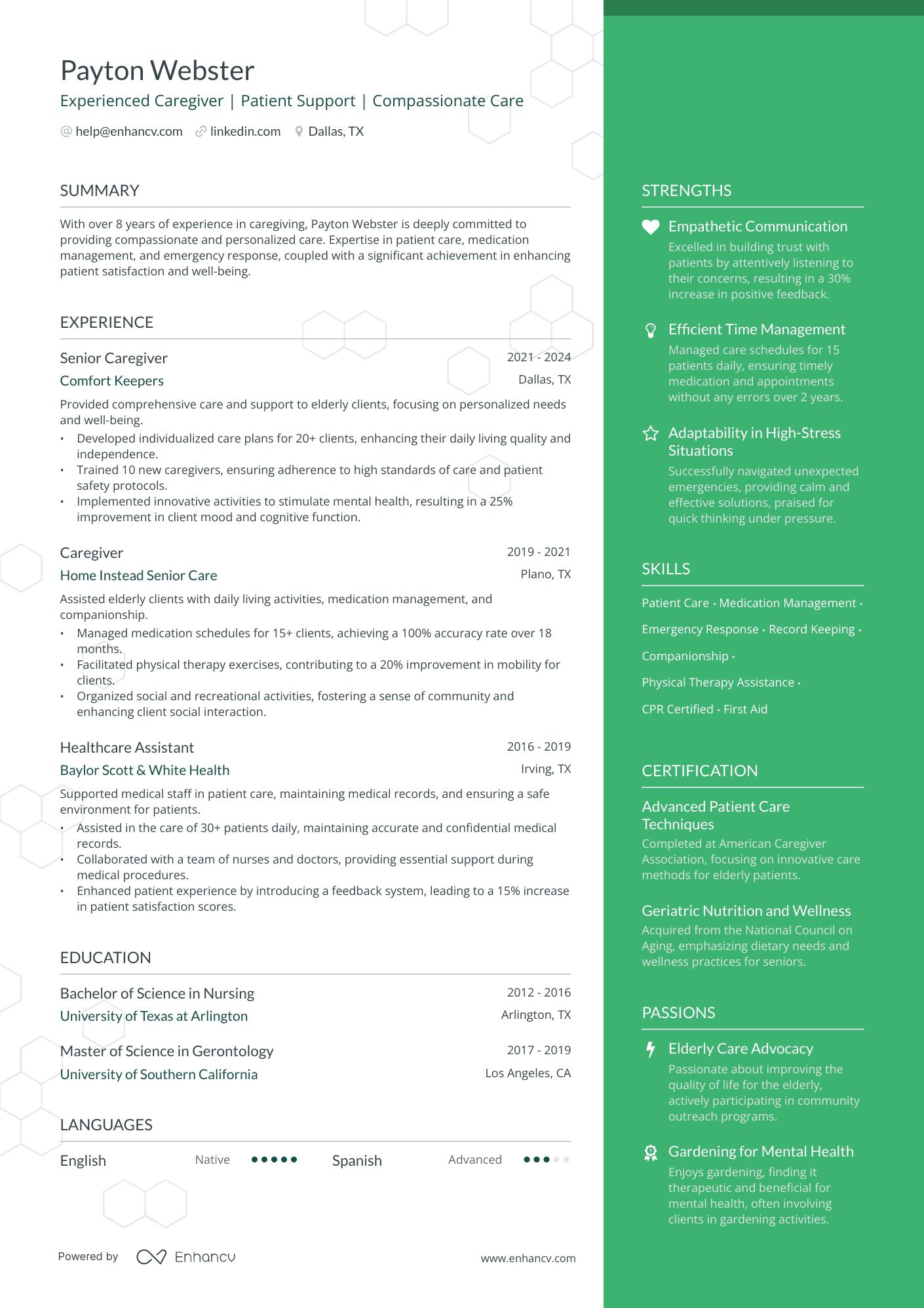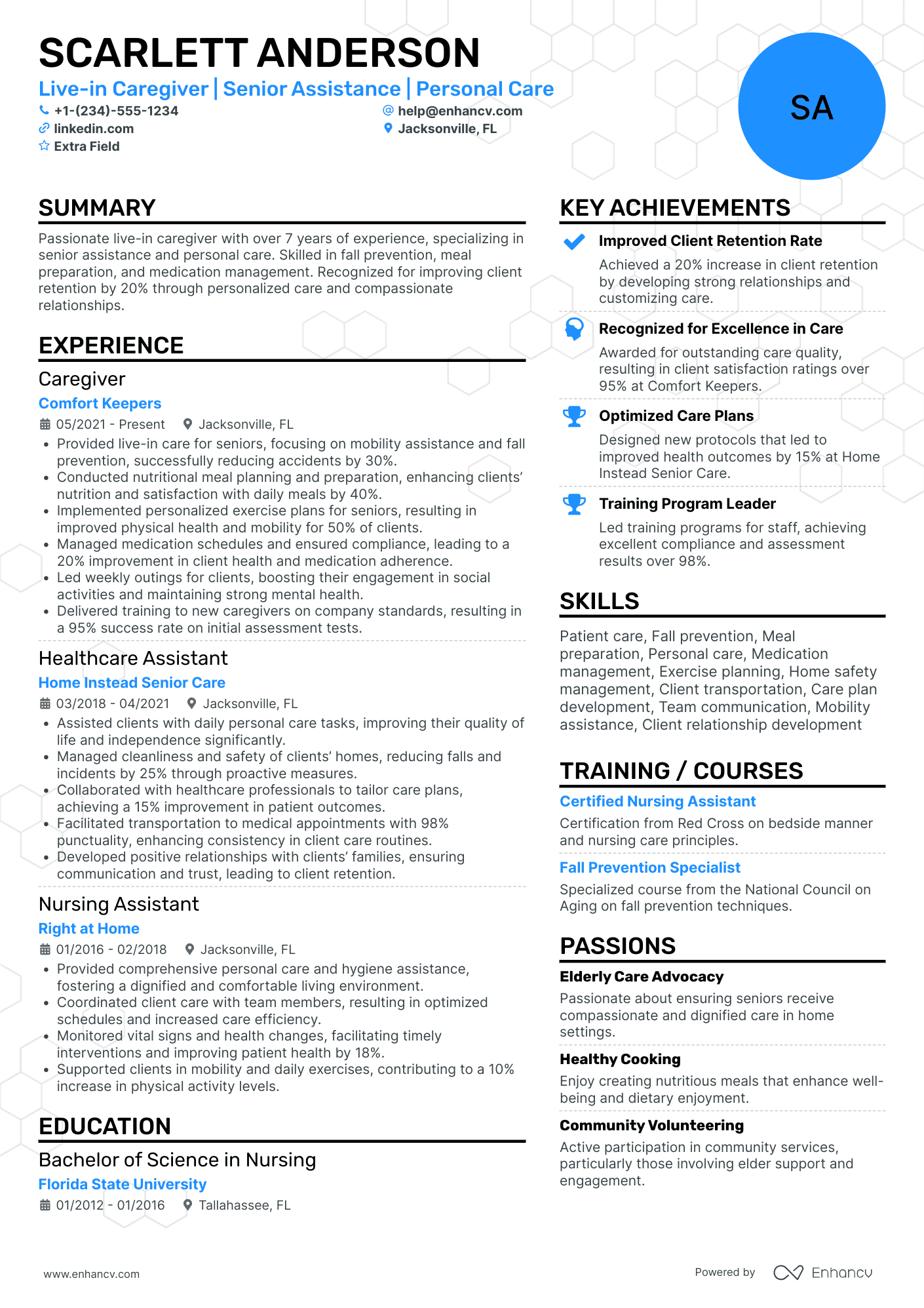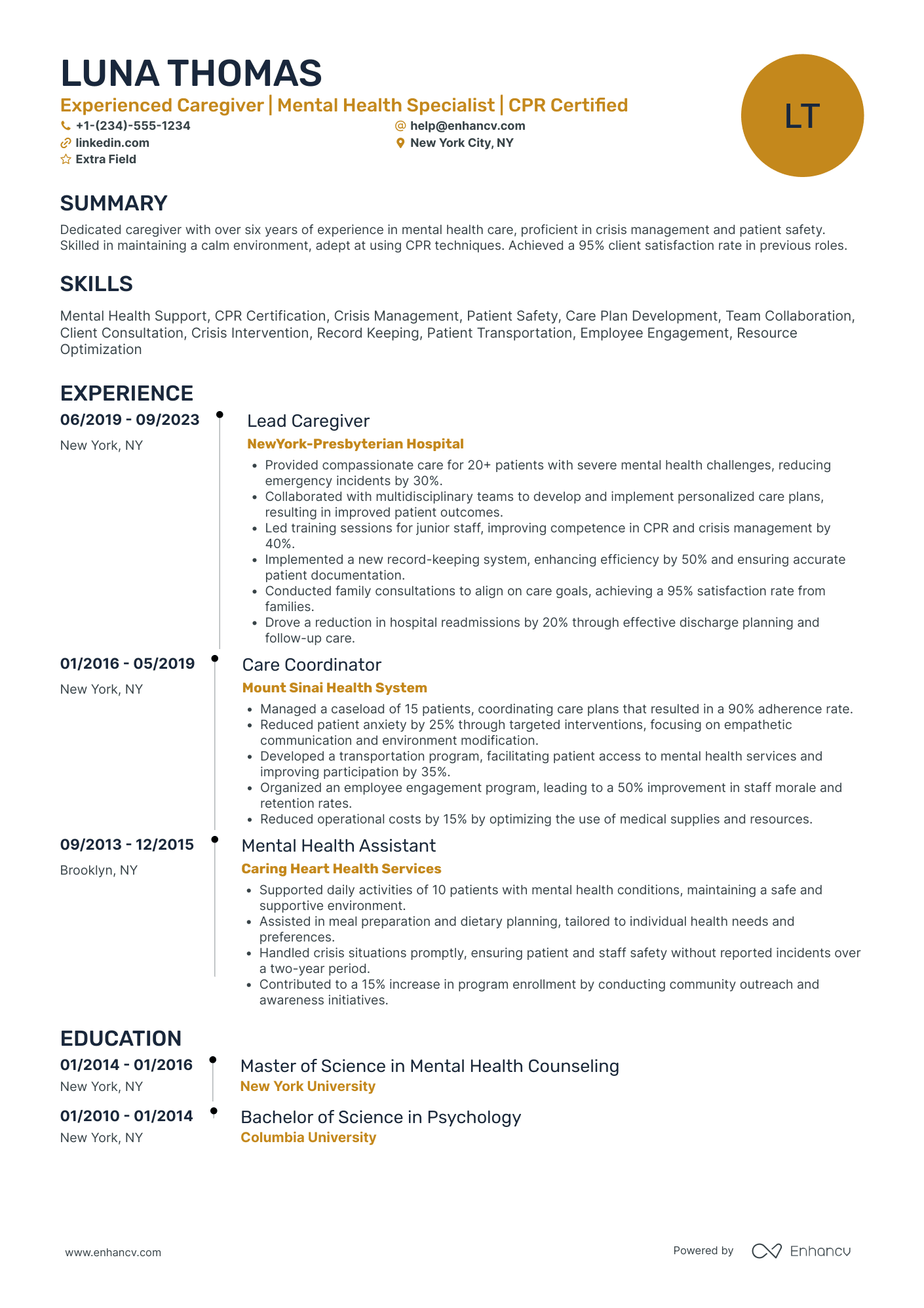Caring for others takes a special set of skills that can be difficult to show on a resume. Using numbers and percentages can show how your actions improved the lives of your patients, but that can sometimes fall short of showing your true passion and dedication to helping others.
It is equally important for a caregiver resume to show passion for helping others as well as demonstrate technical skills, like reading vital signs, administering medications, and reading medical charts accurately.
This guide uses real-world examples to show you how to build an impressive resume for caregivers that scores well with applicant tracking systems and gets the attention of recruiters, hiring teams, and families.
We’ll discuss some of the common problems caregivers have when creating their resumes and how you can:
- Tailor your resume to specific job duties and tasks
- Demonstrate valuable soft skills
- Articulate your diverse skill set
- Highlight informal experience
- The benefit of adding testimonials to your resume
If a caregiver resume is not specific enough for your career goals, check out these links to related jobs:
To give you an idea of what your resume should look like, let’s take a look at a resume for an experienced caregiver:
Caregiver resume example
Right from the start, we can see that Payton is an experienced caregiver who offers compassionate care and patient support. Adding job-specific keywords to the header is an excellent way to grab the recruiter’s attention.
Notice how they highlight several hard and soft skills in the resume summary section, like emergency response, medication management, and providing compassionate and personalized care. Including keywords from the job description in this section will increase your score with applicant tracking software.
Here’s what else Payton does well in their resume:
- Expertise and Achievements: Demonstrates specialized expertise in caregiving with achievements such as enhancing patient satisfaction and wellbeing, and improving client mood and cognitive function.
- Certifications and Education: Highlights relevant education and certifications, including a Master's in Gerontology and certifications in Advanced Patient Care Techniques and Geriatric Nutrition and Wellness, directly applicable to caregiving.
- Quantifiable Successes: Provides quantifiable successes, like a 100% accuracy rate in medication management and a 20% improvement in mobility for clients, showcasing effectiveness in the role.
A pretty impressive resume all around. Now let’s start working on making your resume stand above the rest.
How to format a caregiver resume
Having a properly formatted resume is more important today than before. Many companies are using applicant tracking systems (ATS) to help sort through the hundreds of resumes they receive for a single position.
The first step to scoring well with the software is to use the proper margins, spacing, and fonts. These are all standard settings when you create a new document in Microsoft Word, GoogleDoc, or other word processing programs, so no need to worry about setting them. In case you’d like to know what they are, the standard format is:
- Margins are one-inch all around
- Line spacing is single-space
- Font size is set to 10 or 11 points
When listing your education and resume experience, you want to list them in a reverse chronological order, which is the standard for all resumes.
You also want to use a serif or sans serif font. A benefit of using Enhancv resume templates is it sets all of these settings for you and uses newer fonts, like Rubik, Lato, Montserrat, Raleway, Exo 2, and Volkhov. Nothing wrong with using the classics, like Arial and Times New Roman, but they are a little yesterday.
A caregiver resume will have a minimum of five sections: header, summary/objective, education, work experience, and skills set. Your job is to include all relevant education, skills, and work experience within 1-2 pages.
You’ll notice that some resumes use a two-column format. More experienced caregivers with a lot of relevant work experience may prefer this format as it allows you to add your experience and skills on one page.
After talking about the main sections a little more, we’ll go over some additional sections you can add to showcase your skills.
Keep in mind market-specific formats – for example, a Canadian resume might follow a different structure.
Before we start working on perfecting your resume, let’s see how your current resume stacks up by running it through our resume checker.
The top sections on a caregiver resume:
- Header: This top section will include your full name, job title, and multiple contact information, such as email, phone, and social media accounts.
- Summary/Objective: Here, you will talk about your passion for caring for others, relatable work experience, and why you would make a good fit for the position.
- Skill set: This section will highlight your knowledge of medical procedures and medical equipment, experience with physical, speech, or occupational therapies, and soft skills, like remaining calm in crises and time management skills.
- Experience: List all professional and personal caregiving experiences using a reverse chronological format.
- Education: Include all post-secondary education and state or national certifications.
What recruiters want to see on your resume:
- Proficiency in reading and understanding medical charts, vitals, and medication management.
- The ability to operate and maintain monitoring equipment and proper use of medical devices.
- Are current with CPR and First-Aid certifications and understand all HIPAA regulations.
- Demonstrates their experience with expressing empathy and compassion, strong writing and verbal communication skills, and problem-solving abilities.
- Ability to maintain a professional demeanor during stressful or heartbreaking situations.
When you are ready to submit your resume, save a copy as a PDF (.pdf). This document type will preserve the formatting of your resume and is accessible on applicant tracking systems.
How to write your caregiver resume experience
Creating a resume for a caregiver is not like other jobs. While it is essential to list experience with medical terms and technology, it is equally important to demonstrate your passion and commitment to caring for others.
The resume experience section is where you will list professional and non-professional caregiver experience that relates to the job you are applying for. For each job, you will list the job title, company, or family name, dates of employment, location, and a bullet list of job details
As you create this section, keep in mind some of the common mistakes that caregivers make when adding past work experience:
- Using vague descriptions when describing details of past work
- Lack of showing quantifiable achievements
- Not tailoring their experience to the job description
- Failing to explain gaps in employment
- Not including client or employer feedback
Let’s take a look at a real-world example of a caregiver resume experience:
- •Assisted multiple clients with all daily living activities
- •Prepared meals
- •Assisted clients with exercising with physical and mental exercisees
- •Able to easily lift and turn patients of up to 150 pounds
- •Drive patients to doctor appointments and other errands
- •Perform housekeeping duties
- •Sat with residents to socialize and keep them company during the day
- •Other duties as assigned
In reading this example of resume experience for a caregiver, what impression do you get? There is very little detail about the types of procedures they did, what medical equipment they used, or how they improved their patient's lives.
When detailing your work experience, pick a single verb to describe the people you care for. Using different terms, like patient or client, is unprofessional and gives the impression of not being detail-oriented, which is a necessary skill for caregivers.
Another thing you want to include is a description of the company or work environment. Just listing the name Roseview Home does not indicate whether they cared for one person or multiple.
Let’s try adding in some more details to improve this resume experience:
- •Assisted 35 residents ages 70 to 89 with daily living activities that include, bathing and dress, eating, and medication administration
- •Assisted in prepared meals and snacks and ensuring they follow each residents’ medical or dietary restrictions
- •Supported and encouraged residents to participate in daily mental and physically stimulating activities and exercise programs to build strength and dexterity and restore any lost functions
- •Monitored vitals and updated doctors of residents condition and maintained a calm demeanor when updating resident’s family of any changes to their health
- •Provided basic cleaning and service on monitoring devices, wheelchairs, and bathroom aides, in addition to basic housekeeping duties
- •Able to lift and turn patients of up to 150 pounds
- •Participated in games and social events with residents, including various activities like playing guitar, reading stories, and board games
From this example, we get a clear example of this person’s performance and some of the tasks they did to help their patients.
This example clearly shows:
- They have experience in a large care facility and can manage multiple patients effectively
- The specific details on the duties they performed and how those tasks benefited their patients
- The types of medical equipment they are comfortable working with
- Demonstrates how they can talk with medical professionals and family members to discuss health issues
- Shows how they adapt their creative talents to keep residents entertained and mentally active
caregivers will sometimes have gaps in employment due to caring for family or for other personal reasons.
Caregiver burnout is a real condition. According to the National Alliance for caregivers and AARP Public Policy, 40% of professional and nonprofessional caregivers felt emotionally stressed, while 20% felt physical duress.
You can explain these gaps on your resume with a few short sentences:
“From April of 2004 to December of 2006, I was caring for a close family member during a serious illness. Now, I am ready to return to a professional caregiver role, and I think my qualifications and passion will fit well for the caregiver position.”
Next, we’ll talk about one of the biggest problems when creating a resume for caregivers. Quantifying caregiver work.
How to quantify the impact on your resume
Using numbers to quantify the impact of your resume experience is an excellent way to show off how your skills benefited your last employer.
When applying for a new job, the environment of the position will determine how you quantify your results.
If you are applying for a large care facility, you can say, “Improved patient mobility by 25% using proven physical therapy techniques.” Whereas if you are applying for a job in a family home, you can instead say, “Encouraged and assisted patients in exercise programs that allowed them to walk unassisted for 20 minutes longer than before.”
Here are some examples of how caregivers can use numbers and percentages to quantify the impact of their work:
- Assistance with daily living activities – “Assisted 10 patients every day with bathing, dressing, eating, going to the bathroom, and other daily activities.”
- Improvement in patient health and mood – “Implemented mental and physical activity programs that increased patients' mood and general well-being by 30%.”
- Medication management – “Responsible for medication management for 15 patients that includes administering all types of medication and confirming new medications do not cause any adverse reactions.”
- Efficiency and time management – “Organized patient and caregiver scheduling to decrease wait times by 13%, which allowed for faster response times.”
- Patient or family satisfaction – “Maintained a 98% satisfaction rating during employment.”
- Compliance and safety procedures – “Implemented new safety procedures that reduce the number of patient and caregiver accidents by 10%.”
- Volume of work – “Managed up to 23 residents’ daily activities and appointments to ensure they are active and keeping up with all medical and therapeutic appointments.”
- Attendance and reliability – “Maintained a 100% attendance record for over five years.”
Let’s take a moment to talk about creating a resume for a caregiver with no experience.
How do I write a caregiver resume with no experience
Having no experience should not keep you from applying for a caregiver job. There are plenty of entry-level positions available where you will use any related caregiving experience to show off your skills.
Caregivers with no actual real-world experience can still create an attention-getting resume by making a few simple changes to the format.
- Create a resume objective that lists your career goals instead of a summary that lists past work experience.
- List your education and skills set before your resume experience section.
- Include relatable jobs, such as caring for family members, volunteering at hospitals and care facilities, and any other job where you helped people.
- Include additional sections, like patient/family testimonials, strengths, spoken languages, and professional associations.
When listing relatable work experience, focus on those transferable skills, like active listening and dementia care, so future employers can see you have the experience they are looking for.
Now it’s time to add those all-important hard and soft skills that employers and families want their caregivers to have.
How to list your hard skills and soft skills on your resume
Having a well-rounded list of soft skills is essential for caregivers if they want to give their patients the best care possible. Soft skills are those life experience skills, such as articulating medical knowledge to non-medical family and loved ones and showing compassion for others.
Hard skills are the skills that you learn from teachers and on-the-job experience. They include necessary skills, like:
- Reading vital signs
- Administering medication
- Performing CRP and First Aid
- HIPAA rules and regulations
When writing this section, keep in mind one important fact about applicant tracking systems.
Employers will enter specific keywords into ATS software to search for skills they need. If you write “Able to express empathy” on your resume and the job description says “Shows empathy,” the software may not recognize that as a skill you have.
Always match the skill sets on your resume to the listed skills in the job description word for word.
Best hard skills for your caregiver resume
- Understanding medical conditions and symptoms
- Reading and recording vital signs
- Medical recording and monitoring devices
- Medication management and administration
- Healthcare software
- First aid and CPR training
- Nutrition education
- Mobility assistance
- Assistance with daily living activities
- Incontinence care and management
- Understanding and implementing safety measures
- Knowledge of emergency procedures
- HIPAA rules and regulations
- Accurate documentation and record keeping
- Patient’s advocacy
- Physical endurance
Best soft skills for your caregiver resume
- Showing empathy
- Expressing compassion
- Clear and concise communication
- Active listening
- Remaining calm during crises
- Having patience
- Time management
- Adaptability
- Honoring personal space
- Cultural sensitivity
- Teamwork
- Critical thinking
- Problem-solving
- Stress management
- Self care
- Emotional support
How to list your certifications and education on your resume
Listing your post-secondary education and certifications on your resume is something all caregivers need to include. It doesn’t matter how long ago you completed the degree, future employers and families want to see you have the basic knowledge and understanding for the role.
Potential employers should be able to look at this section and see:
- You went to an accredited university
- The name of the degree
- Your GPA score
- Date of graduation
It will look something like this:
This example is nice and simple. Employers don’t need the details of your education because they can see your real-world experience in the resume experience section.
If you have no experience, you can add bullets to your education to show what skills you have learned:
- •Achieved a perfect score on all medical terminology and HIPAA compliance exams and essays
- •Recieved recognition for outstanding performance during CPR and First Aid training
- •Specialized in holistic care that included meal preparation, playing games, and physical therapy
One thing that will impress families and care facilities is having advanced medical and caregiving training. There are several certifications that you can obtain after graduation that will help you with your career goals.
For this section, all you will need to include is the name of the organization that provided the training and the type of certification, like so:
How to write your caregiver resume summary or objective
The way you write this next section will depend on your experience level.
Caregivers with five or more years of experience will write a resume summary. This will summarize your work experience along with how that experience makes you the perfect candidate for the role.
A resume objective is for caregivers with little to no real-world caregiver experience and who are looking for their first caregiver position. It focuses on their career goals and passions and their willingness to learn.
When writing this section, keep it within 2-3 sentences.
Let’s take a look at a resume summary for a caregiver with 5+ years of experience in child care:
This example does little to show the person’s experience or abilities and is a bit humdrum.
You want to avoid vague terms like “several years of experience” and “multiple children.” Use job-specific keywords to showcase your past skills.
This summary does a good job of including more details about their years of experience. Writing “...over five years of hands-on experience in child care” versus “several years of experience” is what recruiting teams want to see. Right off the bat, anyone reading this would see:
- How many years of experience they have
- A brief glimpse at the kind of experience they have
- Their passion for “early childhood education”
A final note about your resume summary or objective.
Writing this section last is the best choice, as you will want to tailor this section to the specific job. You can include keywords from the job description in this section so that recruiters can see you have the experience they are looking for right away.
Optimize your resume summary and objective for ATS
Drop your resume here or choose a file.
PDF & DOCX only. Max 2MB file size.
Additional sections for a caregiver resume
In addition to the five main sections of your resume, there are a few other ways you can add any relatable work experience and skill set. Some additional sections to consider include:
- Spoken language – Many care facilities will have patients who speak different languages. Add this section if the job description calls for knowledge of other languages.
- Volunteer experience – List any respite or companionship volunteering services you provided for patients during school or part-time.
- Professional associations – List any caregiver organization that you belong to, such as the Alzheimer’s Association, National Family caregiver Alliance, or a local caregiver organization
Another way to show your impact on patients is by adding a testimonial section, especially for at-home or family caregivers.
Patient testimonials are an excellent way to highlight how your work benefited the patient and how you contributed to their well-being. You don’t need to include a lot, just a sentence or two that describes how past employers felt about your performance.
Here are a real-world example of patient testimonials on a resume for caregivers:
Having testimonials like this on your resume can give the reader a sense of how well Payton works with patients and how her efforts improved their lives.
Best job boards to submit your caregiver resume
Now that you have your caregiver resume shined and polished, it’s time to send it out into the world.
Job boards like Indeed and Careerbuilder are fine to use, but why not use a website that specializes in jobs for caregivers.
Create a profile and start a new job search on any of these specialized job boards:
Remember to save your resume in a PDF format to preserve the look of your resume and guarantee they will be able to read it.
Key takeaways
Your caregiver resume is your first introduction to families and hiring teams of small and large-scale care facilities. Be sure to highlight all of your relatable skills and use keywords from the job description to increase your chance of getting an interview.
Throughout this guide, we discussed the importance of:
- Using a properly formatted resume with specific keywords from the job description
- Addressing any gaps of employment
- Quantifying your results and showing the impact your work had through patient or family testimonials
- Adding additional sections to showcase relatable skills that your resume experience does not show
Caregiver resume examples
By Experience
By Role
